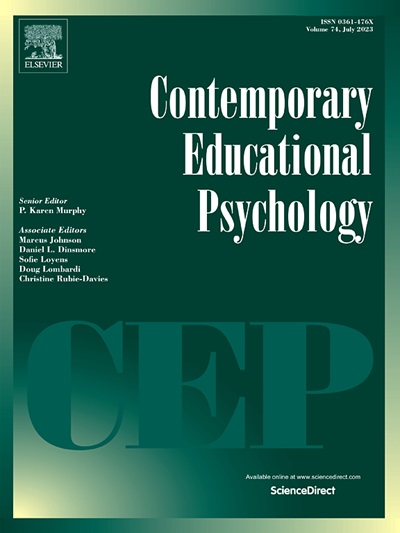情绪语调对计算机学习的影响:来自系统节奏和学习者节奏实验的见解
IF 3.8
1区 心理学
Q1 PSYCHOLOGY, EDUCATIONAL
引用次数: 0
摘要
在多媒体学习研究中,情感设计越来越成为一种有前景的研究途径。然而,人们对两个重要的情绪维度——效价和唤起的影响关注有限。在两个实验中,我们考察了系统节奏(实验1)和学习者节奏(实验2)多媒体课程中背景图像的效价和唤醒的影响。在两个实验中,初中生被随机分配到四种实验条件中的一种,采用2 × 2因子设计,效价(积极与消极)和觉醒(低与高)作为被试之间的因素。在记忆方面,在实验1(系统节奏)中,接受负价值图像的人显著优于接受正价值图像的人。然而,两个实验的结果都没有显示出显著的价激交互作用。对于迁移,实验1的结果表明,高唤醒图像在正效价下显著优于低唤醒图像,而低唤醒图像在负效价下显著优于高唤醒图像。实验2(学习者节奏)的结果表明,当唤醒水平高时,负效图像的表现优于正效图像。除学习成果外,还测量了参与者的认知负荷和内在动机,但在两个实验中,这些测量没有发现显著差异。讨论了影响和未来发展方向。本文章由计算机程序翻译,如有差异,请以英文原文为准。
Effects of emotional tones in computer-based learning: Insights from system-paced and learner-paced experiments
Emotional design has increasingly been a promising avenue in multimedia learning research. Nevertheless, limited attention has been paid to the effects of two important emotional dimensions, which are valence and arousal. In two experiments we examined the effects of valence and arousal of background images in system-paced (Experiment 1) and learner-paced (Experiment 2) multimedia lessons. In both experiments, junior high school students were randomly assigned to one of the four experimental conditions in a 2 × 2 factorial design with valence (positive vs. negative) and arousal (low vs. high) as between-subjects factors. For retention, in Experiment 1 (system-paced), those receiving negatively valenced images significantly outperformed those receiving positively valanced images. However, the results across both experiments did not reveal significant valence × arousal interaction effects. For transfer, the results in Experiment 1 showed that high-arousing images significantly outperformed low-arousing images when positively valenced, while low-arousing images significantly outperformed high-arousing images when negatively valenced. The results in Experiment 2 (learner-paced) showed that negative valenced images outperformed positively valenced images when their arousal levels were high. Apart from learning outcomes, participants’ cognitive load and intrinsic motivation were also measured, but in both experiments no significant differences were found regarding these measures. Implications and future directions were discussed.
求助全文
通过发布文献求助,成功后即可免费获取论文全文。
去求助
来源期刊

Contemporary Educational Psychology
PSYCHOLOGY, EDUCATIONAL-
CiteScore
16.50
自引率
3.90%
发文量
74
期刊介绍:
Contemporary Educational Psychology is a scholarly journal that publishes empirical research from various parts of the world. The research aims to substantially advance, extend, or re-envision the ongoing discourse in educational psychology research and practice. To be considered for publication, manuscripts must be well-grounded in a comprehensive theoretical and empirical framework. This framework should raise critical and timely questions that educational psychology currently faces. Additionally, the questions asked should be closely related to the chosen methodological approach, and the authors should provide actionable implications for education research and practice. The journal seeks to publish manuscripts that offer cutting-edge theoretical and methodological perspectives on critical and timely education questions.
The journal is abstracted and indexed in various databases, including Contents Pages in Education, Australian Educational Index, Current Contents, EBSCOhost, Education Index, ERA, PsycINFO, Sociology of Education Abstracts, PubMed/Medline, BIOSIS Previews, and others.
 求助内容:
求助内容: 应助结果提醒方式:
应助结果提醒方式:


